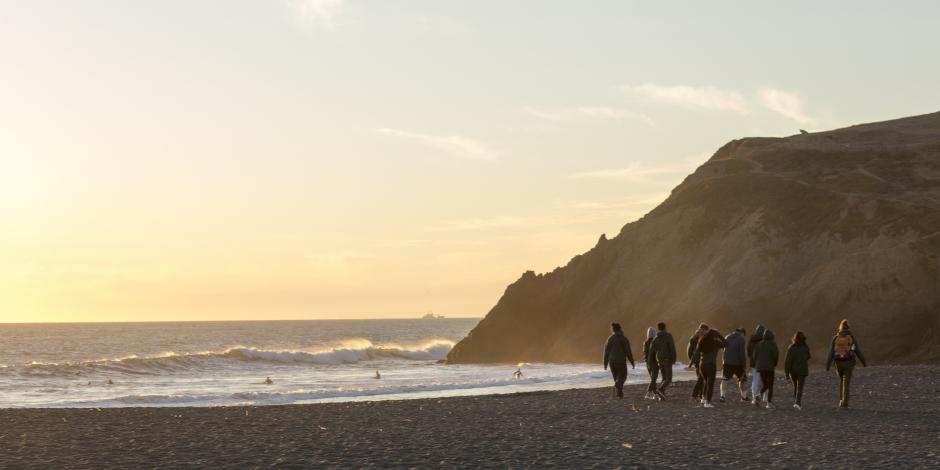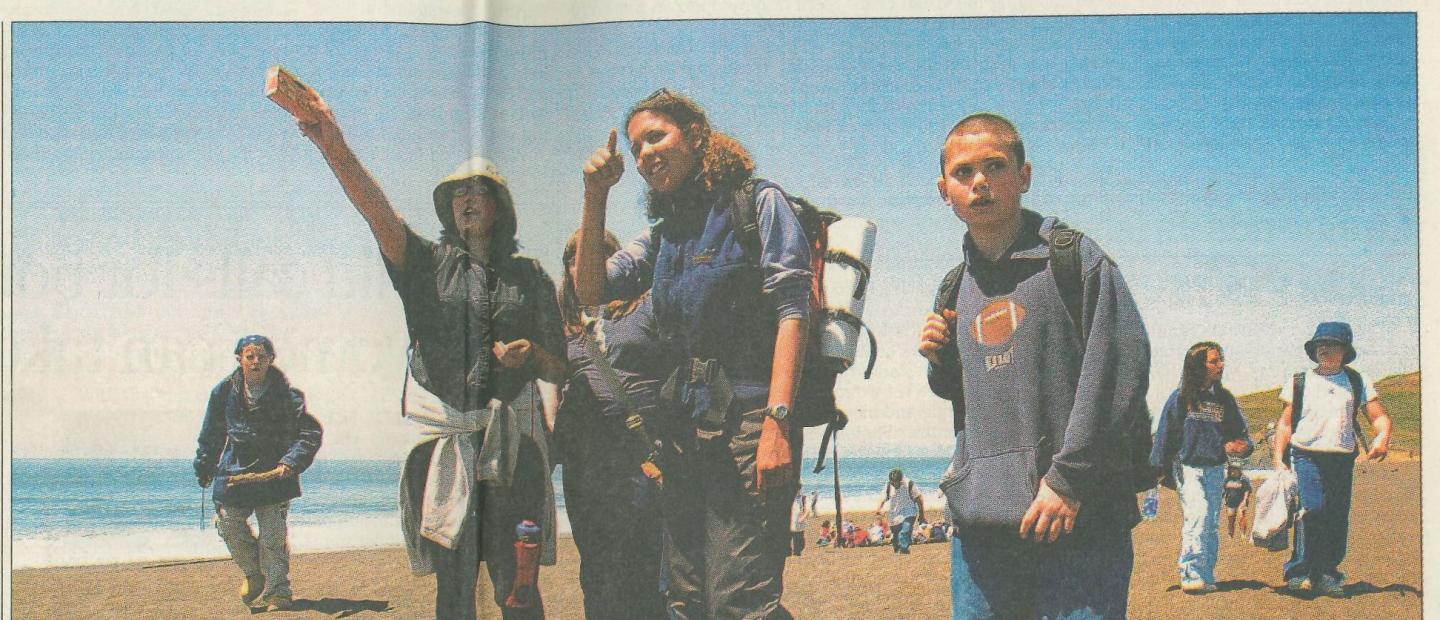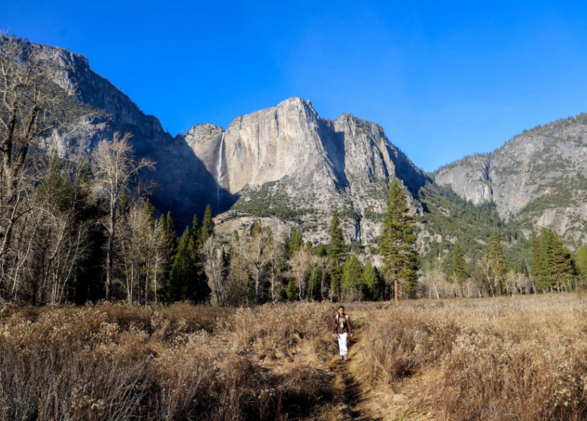50 Stories for 50 Years: Rachel Davis

Rachel Davis is a rare story -- she has seen and experienced NatureBridge from almost every possible angle. She began as an enthusiastic student taking part in a NatureBridge program in Golden Gate National Recreation Area in 1993. Rachel went on to become an intern and then an educator in Golden Gate for years before leaving for a science teacher position at Hamlin School in San Francisco. There, her career came full-circle as she led her students into the national parks to participate in the same NatureBridge programs that once inspired her.
Today, her journey expands even further as the newest member of NatureBridge’s Yosemite Board, where she brings the unique perspective of a former student, intern, educator and teacher. I sat down with her virtually to discuss her improbable journey, the right way to use technology in nature and what the next 50 years of environmental education could look like.
Tell me about that first experience with NatureBridge (then Headlands Institute).
My very first experience with NatureBridge was sophomore year of high school. I was super interested in learning biology and at the time [Headlands Institute] was running programs on the intertidal zone. We spent a few days learning different types of animal kingdoms and what we could expect to find in the area. Then we went out and explored. I was blown away by the Headlands. We got to be hands-on and much more in depth than our usual classes.
Do any memories from that initial trip stand out to you?
I remember the racoons while we were camping! It was so much fun. I actually went to [NatureBridge in] Yosemite two years later as part of a class trip for AP Biology. My Headlands trip was much more focused on science and Yosemite was more about building community, connecting with people and the land. It was winter, there was snow; it was amazing.
How much exposure to nature did you have as a kid before going to Headlands? What was your childhood like?
My parents were both teachers and they were really into camping, backpacking and being outside, so we were outdoors a lot. I think I was seven when we hiked in the high country in Yosemite to the valley, and I remember finding all these cool rocks on the hike and wanting to collect them. So I just had a backpack full of rocks when we reached the valley, which I obviously couldn’t take out of the park. Funny thing is that I became a geology major in college. I was just a very curious kid. Being able to go explore nature and see how things worked, that was always interesting to me.
Can you trace the path of how you went from a NatureBridge student to a NatureBridge educator?
Both of my parents brought students to Olympic Park Institute [NatureBridge’s campus in Olympic National Park, at the time]. My dad had brought students there for over 20 years. So when I was in college majoring in Geology, I was talking to my mom trying to figure out what I should do after I graduated, and she said, “Well, you really enjoyed your trip when you were younger and you went to NatureBridge, and you loved being outdoors, so what if you applied to work there?” I already loved backpacking and working with kids -- probably got that from my parents -- and I thought working at NatureBridge sounded perfect. I applied to be a teacher, but I had no background in teaching other than as a camp counselor. The Headlands Institute told me they couldn’t offer me a job as an educator, but could offer me an internship program.
What was your experience like in the early days of your internship?
I learned so much in those days from some really masterful educators who knew how to take advantage of teachable moments and inquiry based learning. We went pondering at the pond to discover invertebrates, explored the tidepools, and played nature games with students who were engaged in a whole new way. I lived in Rosenstock with a community of educators where we swapped teaching ideas around the kitchen table. I'm still friends with some of the people with whom I worked; we go on backpacking trips to this day.
You became an educator with NatureBridge after your internship, then a few years later, you became a teacher. With two parents who were teachers growing up, did you always know that was in the cards?
I never actually thought I was going to be a teacher. I took a summer when I was working at the Headlands to work at an environmental consulting agency. I had been trained in geology, and wanted to see if that would be a path that I could enjoy. I did not see myself in the consulting world. It wasn’t for me...I didn’t feel the community or connection. When a science teaching position came up at Hamlin I knew that it was my dream job so I jumped at it.

In your time teaching at The Hamlin School, an all-girls school in San Francisco, you’ve been lauded for your citizen science approach with your students. How did you come to bring citizen science into your classrooms?
NatureBridge was doing inquiry based learning before citizen science was even a term. I had an opportunity from Hamlin to go on Earthwatch in Halifax, Canada as a teacher, and I did a blog where I kept in contact with my students who were learning at home [in California] about population density. I would FaceTime with them and give them results daily data, and my students would do graphs and connect what they were learning to the data. So once I returned, I was really interested in citizen science because I loved the idea of everyone being able to collect and participate in scientific inquiry.
You’ve also become an Apple Distinguished Educator, which is connected to your citizen science efforts and your use of technology. How would you describe the way you teach?
I let students ask their own questions and then follow that interest to find the answers. A great example is when Hamlin connected with the Presidio Trust. I lived in the Presidio, a national park in San Francisco. Our school was involved with the restoration of Mountain Lake. I asked the students what they were interested in about the lake and found corresponding citizen science projects. Working with the Trust we were able to set up plant monitoring sites and other citizen science investigations. Students then decide at the end of their data collection they want to give back to the lake so they created signs in Spanish and English which informed visitors about the history of the lake and how they could volunteer to help. Eventually, the Trust had a citizen science conference in the Presidio, and asked if our Hamlin citizen scientists would demonstrate studies they had conducted. So the students showed them how to do citizen science at the lake!
Your sixth grade students were showing adults how to conduct citizen science?
Yes, that was pretty cool.
For nearly two decades, Rachel Davis has been an anchor in Hamlin's science program and a passionate advocate for technology integration and outdoor education. As an educator at a school for girls, she is particularly attuned to gender equity in STEM and spends hours each day teaching her students how to "take up space" with their raised hands, their inquiry and research, their site-based projects and their innovative creations with technology. She cares deeply about the environment; under her care, her students learn to be incisive scholars and effective stewards of the planet.Wanda Holland Greene, Head of School at The Hamlin School
A large part of your curriculum, especially given your award from Apple, has to involve technology. What does that intersection of technology and science look like in your classroom?
I'm actually leaving science, which is really sad, and I am continuing on the technology track. I've been doing two roles: technology and science, but technology integration has students sharing how they can make a difference in the world and that is an exciting new direction my career has taken. A good example of integration was a film competition from the Redford Center Stories, which has students tell their stories and raise their voice about the environment and environmental justice. I encouraged all grade levels to apply and we had 20 videos that students submitted. They had 400+ entries from around the world. My students won the Nautilus science prize for the best science and also won for the best graphics in a film. It was so exciting to inspire our youth so they could have a voice to help inspire change. So even though I'm not teaching science, I can still be in the environmental space and help kids get excited about expressing their ideas. It’s really interdisciplinary...which allows me to be impactful in a different way.
How do you include technology in educational settings in such a way that it doesn’t take away from students’ experience of nature?
Whenever we’d go into the field, we would always have our technology with us, because that’s the most direct, convenient way to record and gather data and that’s what scientists use. I think technology is a great tool but it needs to be used in a space where you are creating rather than consuming in the outdoors. We talk about this a lot: how are you using technology? Are you consuming or are you using it to produce something new that couldn't be created without the help of technology?
Do you think you’ve inspired any future scientists and environmental stewards?
I just recently got a couple of letters from former Hamlin students who are now scientists themselves, which is crazy to me that I have students that found their passion in sixth grade science. That's really an honor. I had one student who is now a sixth grade science teacher and remember my class fondly. That’s so special.
One of the things we as a Board focus on is bringing on new directors that offer fresh perspectives, experiences and qualifications, and are just good people. The perspective Rachel brings to the Board will allow us as a Board to more deeply understand how we can help, not from a conceptual standpoint, but from the real-life experiences she has had as a student and educator.James Hamill, Yosemite Board Chair
A sixth grade science teacher telling her former sixth grade science teacher how much her class meant -- that’s beautifully full-circle. Your own journey feels full-circle as well now that you’re a NatureBridge board member in Yosemite. As the newest member of the board, do you have ideas for its future?
I don't know, I guess it's still pretty fresh. Ask me in a year or so and I’ll have some ideas. I think when you come to a board or any new place, you really want to get to know and understand their direction. Listening and learning is key.
A very scientific approach. With that said, what does being a part of the Yosemite Board mean to you? What do you hope to bring to this dedicated group?
It feels really special. I’m so grateful for the community that I had at NatureBridge and the education I received. I guess my hope is just that I can do something in terms of perspective. I’d like to help us think about the relationship between the environment and technology, and being a person of color, I want to make sure everyone has a seat at the table. Especially in a world that’s changing, everyone needs to have a voice in the struggle.

